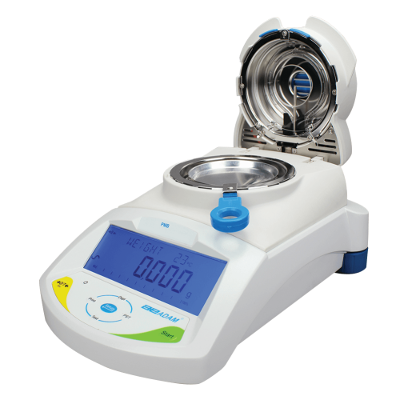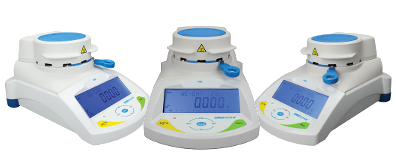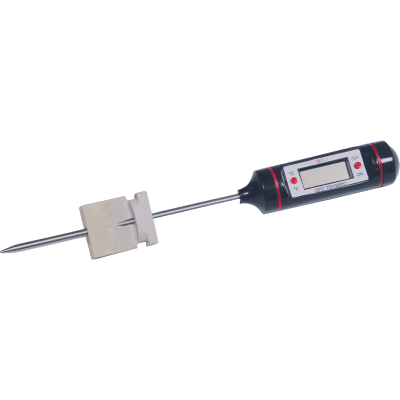
What is a moisture analyzer? What does it do? How do you calibrate a moisture analyzer? We answer these questions and more in this post about moisture analyzers. There are many different devices that can be used for testing moisture in a sample, moisture analyzers eliminate the need for laborious oven testing methods by employing halogen bulbs and other variants to effectively heat and dry samples. In this post, we'll focus on our own PMB moisture analyzer, as we can ensure the information is accurate and specific.
What is a moisture analyzer?
Moisture analyzers are sometimes called "moisture balances". They're instruments that determine the moisture content of various types of samples. The drying procedures are highly customizable, since different things react to different types of drying procedures, well, differently. Moisture analyzers are often connected to computers to observe and analyze the drying process and its effects on the sample. You can save the tests in the instrument's memory to repeat frequent testing parameters without having to set them up over and over again, which saves a lot of time.
How does a moisture analyzer work?
Basically, the moisture analyzer weighs a sample, heats it up to dry it, and weighs it again once it's dry. This is called loss on Drying (LOD), a standard method for measuring moisture. The sample is weighed, heated, dried and weighed again. The weight after drying is subtracted from the weight before, so the loss of moisture is determined using the loss of mass.

Different moisture analyzers have various means of generating heat. Our PMB uses a single 400 watt halogen bulb, which heats the sample in 1 °C selectable increments. Halogen moisture analyzers are quick, efficient and responsive, which makes them ideal for moisture analysis, where there is no single setting that heats all samples evenly; some samples can be dried using constant heating while others have to be heated in specific increments to avoid damage.
The process basically goes like this: start up the moisture analyzer, pick or set testing parameters, put a sample in a tared dish (or sample pan) and close the lid to start the drying process. The analysis happens while the sample is drying. It either ends when the test is over, or after a period of time set by the user. The data is often sent to computers or stored in a flash drive for in-depth analysis and observation. The reports are ISO and GLP compliant.
What is a moisture analyzer used for?
Moisture analyzers are used in a variety of industries for many different purposes. These are some of the most common applications:
Food industry:
Moisture control is paramount in the food industry. Too much moisture can lead to staleness or bacterial growth. Many items are sold by weight, so it's important to make sure customers aren't overpaying for water weight. Too little moisture can reduce the calorie count or make the food dry. Moisture affects taste, consistency, shelf life, appearance and more.
Laboratory:
Moisture analyzers are frequently used in quality control labs and other laboratories. Moisture analysis is used in many fields, to determine the water content in crude oil, fuel, sewage sludge and many other chemicals, solids and liquids.
Moisture analyzer drying modes and what they do:
- Ramp-up:
- The temperature will rise to a specific degree over a set period of time. For example, 125ºC in 10 minutes.
- Single:
- A single temperature. The moisture analyzer will heat to a specific temperature, and stays there for the duration of the test, no matter how long it is.
- Step:
- Heats to one temperature for a set time then to another temperature for another period of time. There are a maximum of 3 settings in the PMB. So you could set it to 100ºC for 3 minutes, 125ºC for 2 minutes and to 150 ºC for 6 minutes.

Why should I use a moisture analyzer instead of oven drying?
Moisture analyzers are usually quicker than ovens, and they do the analysis, calculations and weighing in the same instrument so the process has less steps, which decreases the chances of errors. There is no gap in the data from the beginning of the weighing until the weighing of the dried sample. Moisture analyzers are also more portable, which is ideal if you have various labs or buildings that you need to transport the instrument to. They are also connected to computers and well adapted to data communication and analysis. A moisture analyzer can have multiple test methods, and you can save them for later usage. They can be connected to printers for added convenience.
How to calibrate a moisture analyzer
A moisture analyzer needs two calibrations: weight and temperature. Calibrating for mass is similar to calibrating a balance. You use calibration masses with a known value and ensure that the value matches on the display. The procedure for calibrating the temperature works differently:
- Make sure the moisture analyzer has been on for about an hour, and let it cool for 3 hours if you were using it.
- Put a sample pan in the PMB.
- Place the temperature probe to be used to monitor the temperature on the sample pan.
- Close the chamber.
- Enter the menu for calibration section.
- Select the Temperature Calibration option CAL TEMP.
- Press the [Setup/Enter] key. The display will guide you through the steps necessary to calibrate the temperature of the heating chamber.
- When the analyzer chamber is closed, the display will show 00:00 with the timer running. The timer will count up to 20:00 to allow time for the chamber to come to a steady (room) temperature. During this time, observe the temperature in the chamber. The beeper will sound every minute to remind you that calibration is in progress.
- Record the temperature inside the chamber. When the temperature has been stable and constant for some time, press [Setup/Enter] to enter the lower temperature value. Using the numeric entry method, enter the temperature inside the chamber.
- Press [Setup/Enter] to continue the test. The heaters will turn on and begin heating the test chamber. The timer will show the elapsed time as it did before. The chamber will be heated to approximately 150ºC. After 20 minutes, the beeper will sound.
- Press [Setup/Enter] to enter the second temperature value as displayed. Enter the second value like before, by pressing [Setup/Enter] to confirm and store the value. The PMB will now return to normal weighing.

Calibrating your moisture analyzer frequently is paramount, as the moisture content could be wrong or the samples damaged if the differences are too high. Some samples could damage the moisture analyzer when they burn or cause problems in the laboratory.
Important: Make sure you read the manual to know what the heating and drying settings are, and what substances you shouldn't put in your PMB. Know your materials. Some temperatures or drying methods can cause materials to burn, create smoke or fumes, or even explode. Always check the materials before testing.
We carry temperature calibration kits that can help you quickly ensure your analyzer is producing as accurate a result as possible.
Summary
- Moisture analyzers are scientific instuments that are used to heat and dry samples for accurate moisture determination in food products
- Moisture analyzers use the Loss on Drying (LOD) method for accurately measuring moisture content within samples
- PMB halogen moisture analyzers use a halogen bulb in order to heat and dry samples in 1 °C selectable increments
- Moisture analyzers are fast an efficient devices for heating samples quicker than traditional oven drying methods.
- It is essential that your moisture analyzer is calibrated frequently to ensure accurate results and prevent damage to samples - temperature calibration kits can help to ensure this.
If you require further information about moisture analyzers or would like to find out more about the PMB range of moisture anlyzers we offer please contact us.

